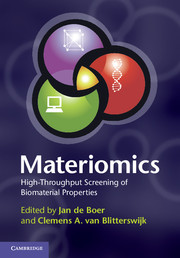Book contents
- Frontmatter
- Contents
- List of contributors
- Preface
- Chapter 1 Introducing materiomics
- Chapter 2 Physico-chemical material properties and analysis techniques relevant in high-throughput biomaterials research
- Chapter 3 Materiomics using synthetic materials: metals, cements, covalent polymers and supramolecular systems
- Chapter 4 Microfabrication techniques in materiomics
- Chapter 5 Bioassay development
- Chapter 6 High-content imaging
- Chapter 7 Computational analysis of high-throughput material screens
- Chapter 8 Upscaling of high-throughput material platforms in two and three dimensions
- Chapter 9 Development of materials for regenerative medicine: from clinical need to clinical application
- Chapter 10 Non-biomedical applications of materiomics
- Chapter 11 Beyond bed and bench
- Index
- References
Chapter 6 - High-content imaging
Published online by Cambridge University Press: 05 April 2013
- Frontmatter
- Contents
- List of contributors
- Preface
- Chapter 1 Introducing materiomics
- Chapter 2 Physico-chemical material properties and analysis techniques relevant in high-throughput biomaterials research
- Chapter 3 Materiomics using synthetic materials: metals, cements, covalent polymers and supramolecular systems
- Chapter 4 Microfabrication techniques in materiomics
- Chapter 5 Bioassay development
- Chapter 6 High-content imaging
- Chapter 7 Computational analysis of high-throughput material screens
- Chapter 8 Upscaling of high-throughput material platforms in two and three dimensions
- Chapter 9 Development of materials for regenerative medicine: from clinical need to clinical application
- Chapter 10 Non-biomedical applications of materiomics
- Chapter 11 Beyond bed and bench
- Index
- References
Summary
Scope
High-content imaging (HCI) plays a pivotal role in high-throughput screening (HTS) of biological responses to biomaterials. This chapter will give a brief introduction to its basic principles by explaining the most commonly used imaging techniques, describing the general structure of an image analysis pipeline and providing a summary of available HCI software. Special emphasis will be devoted to the initial steps of image analysis such as image correction, segmentation and feature extraction. Additionally we include a brief overview of relevant literature and description of promising new tools for HCI. Finally, two classic experiments will be described, which use state-of-the-art HCI in biomaterial science by experts in the field.
Origins of high-content imaging
The first person to observe micro-organisms with a microscopic device was the Dutchman Antoni van Leeuwenhoek (1), who was able to make and polish tiny lenses of high curvature which were the forerunners of the modern microscope. Robert Hooke, the English father of microscopy, later improved on the design and confirmed van Leeuwenhoek’s findings. Since then, light microscopy has evolved into its modern incarnation. The first use of fluorescence microscopy in biology was in 1881 when the bacteriologist Paul Ehrlich used fluorescin to observe the aqueous humour in the eye. The first immuno-staining was performed in 1950 by Melvin Kaplan (2). Green fluorescent protein (GFP) was the first fluorescent protein used in biology. It was isolated from jellyfish in 1961 by Shimomura and co-workers, and it was cloned by Prisher in 1992. The ability either to use antibody conjugated fluorophores or to clone GFP into chimaeric proteins led to the implementation of the fluorescence microscope in modern biology. High-content imaging (HCI) is the automation of fluorescence microscopy whereby the manual interpretation of images is replaced by computer algorithms.
- Type
- Chapter
- Information
- MateriomicsHigh-Throughput Screening of Biomaterial Properties, pp. 85 - 100Publisher: Cambridge University PressPrint publication year: 2013



